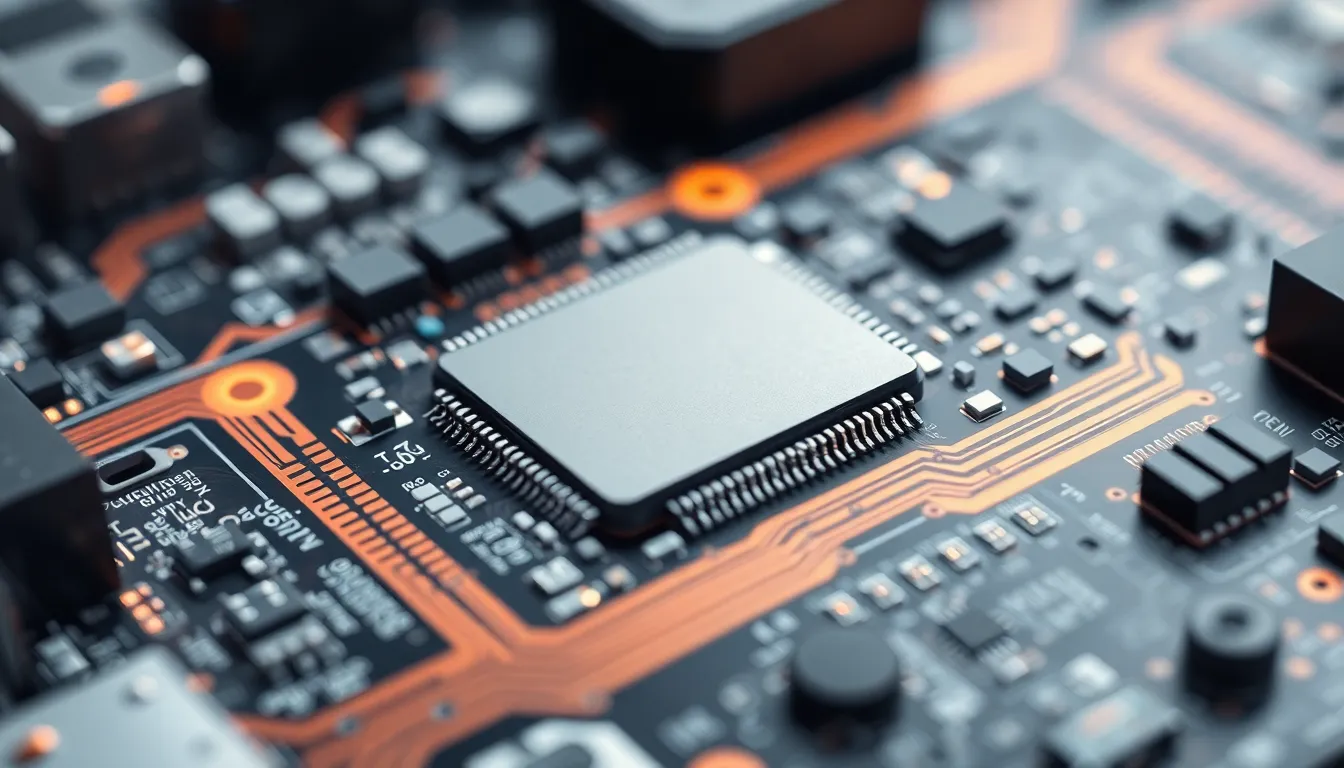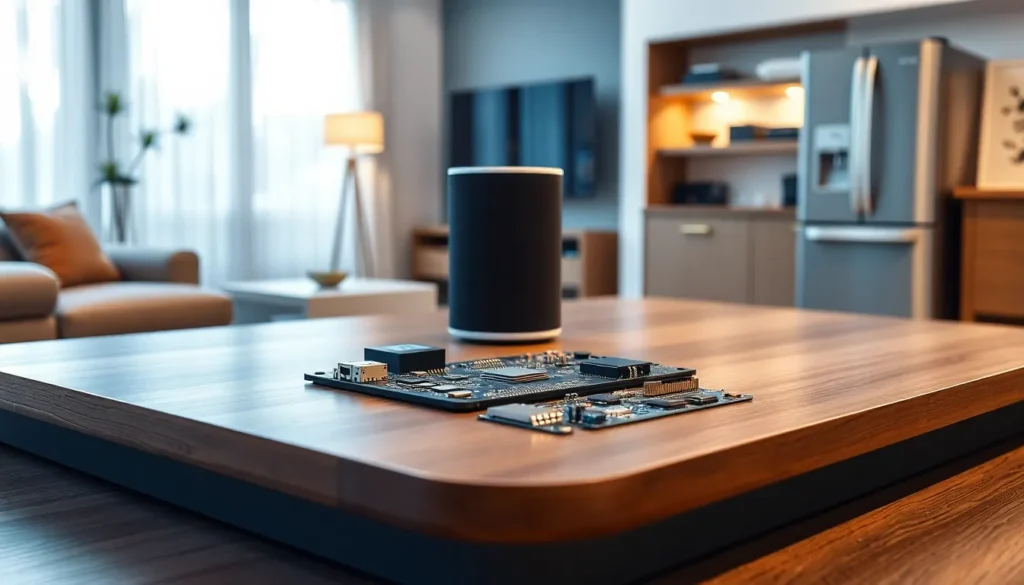Table of Contents
ToggleIn a world where even toasters can tweet, smart device hardware is the unsung hero powering our daily lives. These tiny tech wonders are the brains behind everything from your voice-activated assistant to that smart fridge that judges your late-night snacking habits. Imagine a life where your devices not only make your mornings easier but also keep you entertained with a side of sass.
Overview of Smart Device Hardware
Smart device hardware consists of essential components that enable functionality in various technologies. These components include processors, sensors, memory, and connectivity modules. Processors handle data processing tasks, ensuring smooth operation in devices like smart speakers and wearables. Sensors detect environmental changes and user inputs, enhancing interaction and responsiveness.
Memory plays a critical role in storing data and applications. Many smart devices incorporate both volatile and non-volatile memory types, which support seamless operation and fast access to data. Connectivity modules allow devices to communicate with each other and establish internet connections, enabling features like cloud storage and remote access.
Power management systems ensure that smart devices operate efficiently while maintaining battery life. Increased energy efficiency becomes particularly important for wearable devices that rely on limited battery power. Manufacturers design these systems to optimize energy consumption while maintaining performance.
Integration of artificial intelligence chips in smart devices has transformed their capabilities. These chips support machine learning applications, allowing devices to learn from user behavior and adapt accordingly. Homes are becoming more personalized as devices utilize this technology to provide tailored experiences.
Security features safeguard smart device hardware by protecting user data from unauthorized access. Various encryption methods and biometric sensors, such as fingerprint readers, prevent unwanted breaches. As smart devices become more prevalent, continuous efforts to enhance security remain a priority for manufacturers.
Smart device hardware encompasses numerous components and technologies that collectively power modern conveniences. Understanding these elements helps consumers make informed choices when integrating smart technology into their lives.
Key Components of Smart Device Hardware

Smart device hardware consists of various essential components that work together to enhance functionality and user experience. Understanding these elements clarifies how smart technology operates and influences daily life.
Processors and Microcontrollers
Processors play a critical role in data processing for smart devices. These chips execute instructions, enabling devices to perform tasks quickly. Microcontrollers, often embedded in devices, manage specific functions and offer control over hardware operations. They integrate memory, I/O ports, and timers to streamline processes. Examples include ARM processors in smartphones and Atmel microcontrollers in home automation devices. Speed and efficiency are crucial, as they directly affect a device’s performance and user experience.
Sensors and Actuators
Sensors are pivotal for interaction in smart devices. They detect environmental changes, such as temperature, light, or motion. Actuators, on the other hand, are responsible for physical movements or changes in the devices based on sensor input. An example of this is how a motion sensor triggers a light bulb to turn on. Various sensors serve different purposes, with humidity sensors in smart thermostats and cameras in security systems among the most common. The combination of these components enhances automation and responsiveness in smart technology.
Connectivity Modules
Connectivity modules enable smart devices to communicate with each other and the internet. Various technologies, such as Wi-Fi, Bluetooth, and Zigbee, facilitate seamless connections. They support data transfer, remote control, and cloud integration. For instance, smart home devices often utilize Wi-Fi for accessing user data or Alexa for voice commands. Each connectivity option presents unique advantages, influencing performance and range. Effective communication between components is essential for the full potential of smart technology to be realized.
Performance Considerations
Performance is a key factor in smart device hardware. It encompasses processing power and energy efficiency, which significantly influence device functionality.
Processing Power
Processing power plays a vital role in the capability of smart devices. Fast processors enhance data handling and multitasking, leading to smoother user experiences. The CPU, or central processing unit, executes instructions and runs applications efficiently. Devices with powerful GPUs, or graphics processing units, deliver rich visuals, particularly in gaming and video streaming. Many smart devices integrate low-power processors to strike a balance between performance and battery life. Specific examples include Qualcomm Snapdragon and Apple A series chips, which excel in mobile computing. Adequate processing power ensures seamless operation of software features, such as voice recognition and real-time data analysis.
Energy Efficiency
Energy efficiency remains a critical aspect of smart device performance. Efficient hardware designs reduce power consumption while maintaining functionality. Many devices utilize energy-efficient processors that scale performance based on workload, conserving battery life during less intensive tasks. Dynamic frequency scaling and sleep mode settings allow devices to optimize energy use without sacrificing responsiveness. Furthermore, advancements in energy harvesting technologies, like solar panels and kinetic energy converters, enable prolonged operation without frequent recharging. Manufacturers emphasize energy-efficient designs to meet consumer demands for longer battery life in wearables and IoT devices. Keeping energy efficiency in mind can significantly enhance the overall user experience.
Emerging Trends in Smart Device Hardware
Emerging trends in smart device hardware showcase the evolution of technology and its integration into daily life.
Miniaturization
Miniaturization plays a vital role in smart device hardware. Smaller components lead to more compact devices that enhance portability. Components like processors and sensors now utilize advanced fabrication processes to reduce size while improving functionality. Many devices now incorporate system-on-chip designs, combining multiple functions into a single chip. This trend allows manufacturers to create thinner, lighter devices without compromising performance. Examples include wearables like smartwatches, which house processing power and connectivity features in slim designs. Ultimately, this focus on miniaturization enables users to carry powerful technology conveniently.
Integration of AI Capabilities
Integration of AI capabilities transforms the landscape of smart devices. Smart devices now utilize dedicated AI chips that enhance performance and personalized experiences. Advanced machine learning algorithms analyze user behavior, adapting to individual preferences in real-time. Various gadgets, from smart speakers to home security systems, utilize AI to improve functionality and user interaction. Enhanced voice recognition and predictive capabilities demonstrate the effectiveness of AI in everyday devices. By embedding AI in hardware design, manufacturers create products that respond intuitively to user commands. This trend significantly elevates the overall user experience and promotes smarter technology use.
Smart device hardware is undeniably shaping the way people interact with technology in their daily lives. As advancements continue to emerge the integration of AI and miniaturization is paving the way for more efficient and user-friendly devices. This evolution not only enhances functionality but also makes technology more accessible and enjoyable.
The ongoing improvements in processing power and energy efficiency are crucial for delivering superior user experiences. By understanding these components consumers can make informed decisions when selecting smart devices that best fit their needs. As the landscape of smart technology evolves staying updated on these trends will ensure users can fully leverage the capabilities of their devices.







